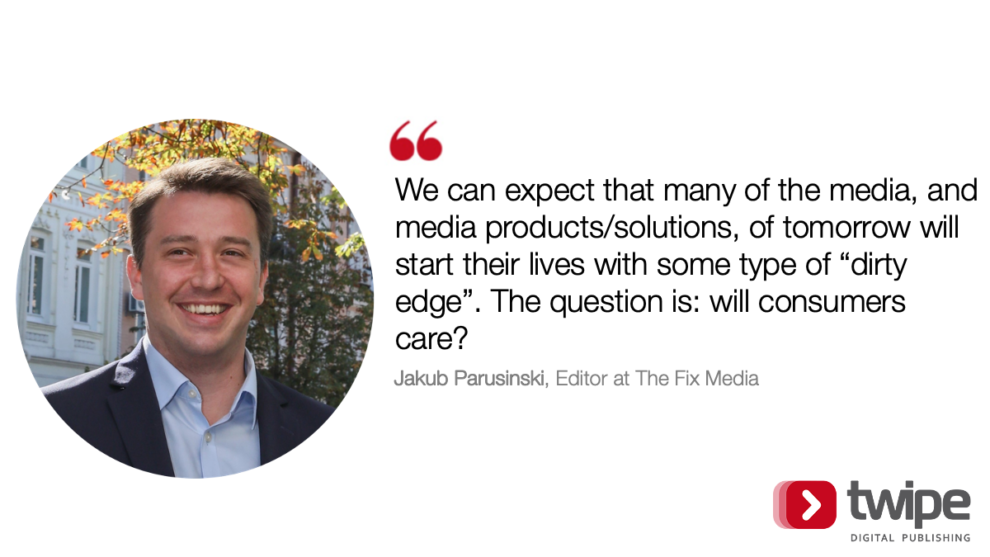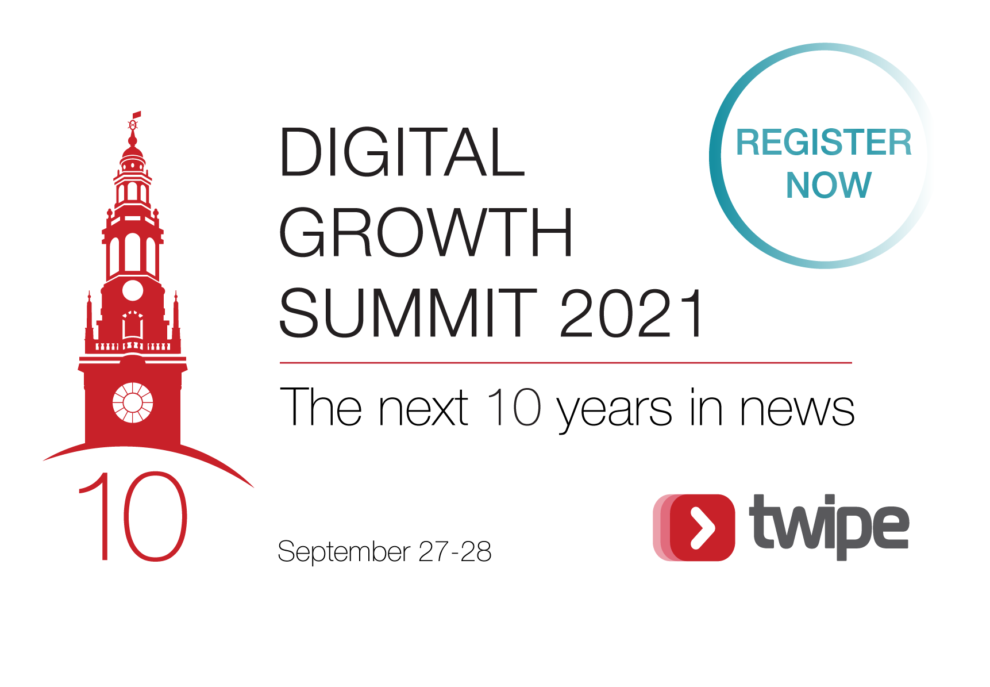
Written by Jakub Parusinski, Editor at The Fix Media – Speaker at Twipe Digital Growth Summit 2021
Rule-breaking is in the DNA of the media industry. It favours the bold, the creative – the loud, and brash, new kids on the block. Over the coming decade, those “new kids” will come from a more diverse list of places than ever before.
This is one of the profession’s most admirable features. Unlike so many other markets that are overwhelmingly rigged in favour of incumbents, media has at least elements of a true meritocracy. If you find a more innovative and louder way to get your message across – and put in the effort to make it work – you have a decent chance even against better resourced and larger competitors.
But this jungle is also frequently brutal and unforgiving. Changes in formats of distribution, consumer preferences, or even what defines credibility can appear suddenly and at scale. Those who fail to adapt can see their models fall apart before their eyes in an instant.si
Radical bundling and unbundling
So, what might the disruptions of the next ten years look like? While it understandably difficult to precisely predict innovations, there are a couple of mechanisms that tend to appear time and again.
One is the cyclical bundling and unbundling of products. Just look back at the Craiglist saga. Back in the 1980s and 1990s classified ads were the golden goose of newspapers – people would pay $10, $20 or $50 to sell their bike and find a roommate.
Along came Craig Newmark offering a cheaper (or often free) alternative. With a staff of just two dozen, he delivered better value for less and literally ate legacy media’s lunch. Classified ad revenue in the US peaked at $19.6 billion in 2000. By 2012 it was just $4.6 billion. But it would be wrong to blame Newmark for this – the real culprit was the complacency of then media executives.
We are currently seeing a similar unbundling with the rise of newsletters. Whether it’s individual journalists leaving newsrooms (they can literally earn millions), or local media launching under the guise of a low-cost, paid newsletter model – it turns out that the disruptive tech of 2020-21 is email.
Moreover, its’ very simplicity puts a premium on creativity – one Berlin-based creator I recently spoke with explained how she built a subscription list of 15,000 in part by dropping flyers in popular hang-out spots around the city.
Conversely, social media outlets are currently in the bundling phase – opening marketplaces, content monetisation solutions, short video services… This is an integral part of Facebook’s acquisition strategy. Whatsapp and especially Instagram both serve to funnel traffic and exist as lifeboats in case users leave. Mark Zuckerberg seems to have realised the lesson of newspapers, and MySpace – no matter how big you are, you are always at risk of a swift decline.
Over the next ten years we will likely go through several cycles. The recent spike in non-news driven subscriptions at the New York Times likely heralds service-aggregator plays by industry heavyweights. But ambitious entrepreneurs will look to the best performing pieces and try to carve them out with lower cost, higher value models – if someone builds up a market using cost-centres as part of their model, you can (relatively) easily come and build a product with them.

Innovation from unexpected places
While it is difficult to predict what the exact disruptions of tomorrow will be, it is much easier to predict where they will come from. The answer: everywhere, but especially emerging markets with strong tech talent, a hunger for big success and lax regulatory environments.
For many decades now the United States (and to a lesser extent Western Europe) set the pace when it comes to product innovation. This is both due to significant soft power that translates into consumption habits – trends move from Los Angeles or London to Lima or Lagos – and perhaps more importantly a vast financing ecosystem that supports entrepreneurs.
Those factors are no longer so significant. There are now substantial pools of capital chasing innovation in emerging markets. Audiences, meanwhile, are more ready than ever to consume creative products from around the world (a big thanks is owed to Netflix, which popularised content from parts of the world with limited international track record).
TikTok, which reached a billion users faster than any previous social media platform, is perhaps the best example. The question is when the next competitor comes from India or Brazil.
Consider the following scenario. You’re an ambitious entrepreneur in a developing country. Maybe you picked up some skills working in outsource hubs for top tech firms. Or you have especially creative content ideas. Unlike consumer, pharma, or banking – which all require substantial capital and/or IP – media offers a relatively low-cost (although high-risk) chance to make it big.
We are already seeing these trends play out. A growing set of Eastern European media solution providers are looking to serve the global market with AI and Machine Learning-powered products, notably leveraging their lower cost base vs. Western peers.
There is also another reason that innovation is more likely to come from emerging markets – fewer and messier rules. Start-ups in the EU and US face a heavy upfront regulatory burden, especially when it comes to data privacy. Those in developing markets simply don’t have the same hurdles to start with (though they may need to deal with them once they scale globally).
This is not something that is always in the interests of consumers. Just look at the boom of fake news coming out of then Macedonia during the 2016 US election. We can expect that many of the media, and media products/ solutions, of tomorrow will start their lives with some type of “dirty edge”. The question is: will consumers care?
Global generation looking for smart, useful, fun content
There has been much ado about the declining interest in news content by the young people of today. The latest Reuters Digital News Report shows that interest in news has been declining over the past 5 years. Moreover, much of what is read is simply scanned – a 2015 Pew and Parse.ly study found that the average engagement with short-form content was under a minute.
But this is partially a formatting question. The digital world – and the younger generation – is moving faster and is hungry for intellectually stimulating content. Unfortunately, (most) legacy media are just not keeping up.
It is not entirely surprising to learn that the biggest European news channel on TikTok is not the BBC or The Guardian, but rather Ac2ality, a Spanish start-up with just a handful of staff. Their goal is challenging but simple – be quick, clear and comprehensive. It’s videos, typically a minute long, have already attracted an audience of 2.8 million followers in just over a year.
Popular science content is also booming – something individual creators like Mark Rober are taking advantage of. His approach: to create a video a month, with significant costs each time, which is highly-produced and informative(ish). While it is not always news – the topics range from the Mars Rover landing to blowing up glitter-bombs – they can get 20 or even 40 million views.
Now consider that real-time, indistinguishable translations are just around the corner. It is almost certain that creators around the world will try to peel off profitable or at least promising topics. If only by pure statistics, they are more likely to succeed – there are more young people in emerging markets who can throw more attempts at a given niche.
This is already happening with topics like make-up tutorials, parenting life-hacks or recipes. These could have been run by The Guardian or The New York Times, but instead traffic is going to creators from Ukraine or Russia. They have shown themselves to be adaptive in terms of platforms and dogged in the pursuit of content the audience wants.
Over the next ten years such emerging players, such mavericks, will be a major force to be reckoned with. Established players will need to be equally bold, and creative, to keep their place at the table.
Don’t miss your chance to hear from Jakub and our host of globally renowned speakers from across the world at Digital Growth Summit 2021!

